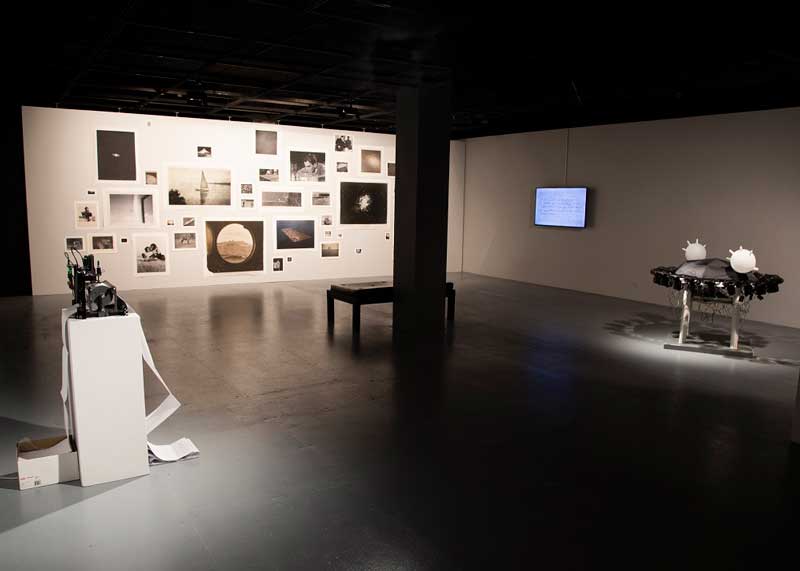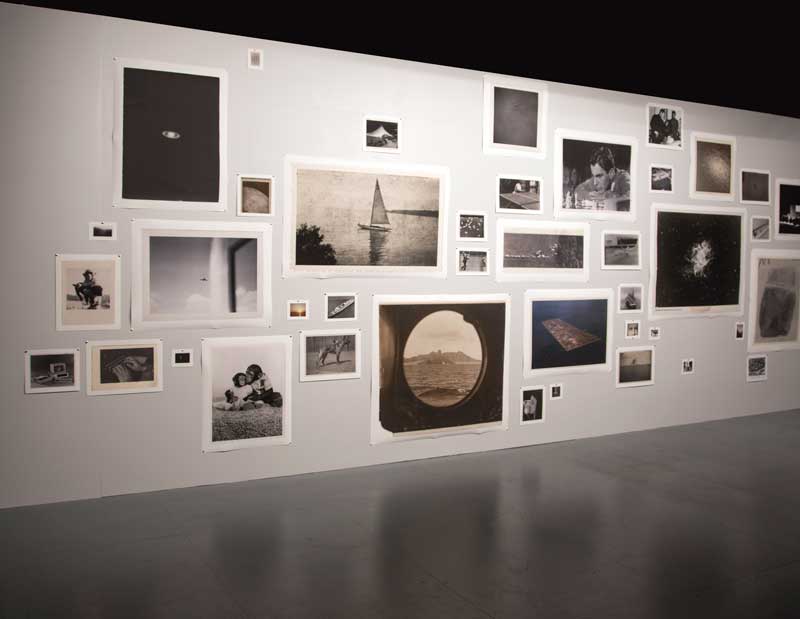.jpg)
There is some irony in the choice of title for this exhibition. The term “Systematic” generally implies that something is done in an ordered and efficient manner or is conducted according to an agreed and often fixed, logical system. Think criminal investigation or even factory management practices. To deviate from such set systems is to invite confusion, chaos and potential failure.
In Systematic curator Eliza Burke has brought together a group of artists under the proposal that their art conforms to the principles of Systems Art, that is art whichis influenced by cybernetics and systems theory, reflecting on natural systems, social systems and social signs of the art world itself. It emerged as part of the first wave of the conceptual art movement in the 1960s and 1970s and continues to be developed in numerous forms as technology advances.

The irony referred to earlier concerns the fact that many “Systems Artists” question and subvert the common understanding of what a system actually is and how any system can be regarded as fixed and infallible or immutable. It is common throughout art that the artist is capable of standing outside conventional beliefs and practices, that is after all how art moves forward. It’s place as a practice has always been to extend boundaries, to refuse to accept without question and to challenge orthodoxies and ideologies.
If one was to ask the question “Where is the avant-garde today?” this is perhaps the site where the concept may have validity. It is also true that technology and applied methodologies from a variety of non-art sources have always been critical to the expansion and extension of art forms and practices. This could be the parallel inventions of the flat brush and prepared oil paint available in tubes which essentially made Impressionism possible. But artists have always freely plundered any available material or technology and incorporated it into their practices.
.jpg)
In the digital age these possibilities are numerous and freely accessible and with the exponential advancement of digital and mechanical developments the field is increasingly broadening and becoming the signature of the current age. It also causes art to further engage, intervene and even collaborate with other more established disciplines, especially science, but also social and political issues. We do well to remember that while these disciplines are also advancing in their own ways they are more fixed as disciplines in principles and practices than art itself is. Art is not a discipline. It is an area of activity that of its very nature ranges across fields, has no central ethos and is flexible and mutable. It resists agreed ideologies or “systems” which both define and direct other disciplines and other organised activities. Defining art this way is sufficient to understanding how it operates within the whole socio-cultural field.
The artist not only subverts systems by applying them to the field of art practice, thereby opening them out to investigation but also tests the common acceptance that systems are infallible. The earliest record of an awareness of systems came through direct observation and acceptance that things which occurred with regularity and predictability, whether that be the movements of celestial bodies or the life cycle of a plant, accorded to a system. This is the basis of science of course. But these are what I would call external systems. At some point we realised that they too could invent and utilise systematic practices, organised and effective, provable in practical terms and able to be passed on and refined over time. Any activity can be systematised and the world today is utterly consumed with systems on the micro and macro levels.
.jpg)
The artists in this exhibition question the concept of system itself. While the work ranges broadly in form many of their stated responses support the primary concept that how objects work and how systems work is the key issue. As the curator states in her excellent catalogue essay, “As the sophistication of modern technologies produces more complex relationships between human and non-human systems, “the way things are done” has emerged as a constant question amidst a diverse and, at times troubling, field of variables.”[1]
Ian Burns has a background as an engineer with a “profound fear of being bored.” For him, as he related in an artist talk, “The main driver is how does it work?” His work Circle, 2016, consists of twenty electrical rotary fans arranged in a circle inside of which sits an umbrella and two floating white inflated latex gloves. Its charm lies in the fact that it employs elements regarded as specifically purposed objects here deployed in an apparently nonsensical manner. Echoes of Dada emerge through the apparently pointless conjunction of elements and their placement in a new form and context. The result is playful and amusing and far from pointless as it questions the validity of delimiting objects to specific and restricted functional contexts.
Like Burns, at the basic level, Bill Hart is engaged with “Taking apart and re-purposing.” His two works in Systematic explore language within technology. Prototype for a Philosophical Prothesis, 2018, is essentially a writing machine. The object presents a fascinating marriage of computer-based technology with a mechanical construction driven by contemporary digital input. The content of the “writing” arises from algorithms developed from fragments of philosophical texts about consciousness. These are “hand” written onto a potentially endless roll of paper in a script which resembles human handwriting. Hart says “My ultimate machine would spit out a philosophy for a new age.”
.jpg)
Hart is questioning whether the future is “Utopia or Dystopia”, an urgent issue to consider at this time. Hart states that “Humans are basically lazy. We analogise ourselves to our current ‘best’ systems.” Hart’s machine randomly generates a text that is replete with possibilities for consideration and that form fascinating relationships, conjunctions and juxtapositions which stimulate new considerations. Its quaint “handwriting” creates a sense of human connection although we are aware that this is entirely the work of the computer and its mechanical manifestation. It also presages a world in which artificial intelligence could become actual fact as the human organism and the digital brain interact. He forces a concern about what that might mean in terms of our future relationship with technology.
Tricky Walsh admits to a “fascination with disassembling and re-assembling” but one must not assume that this relates only to the physical nature of the end result. It also refers to the same process in relation to the content. Her series of paintings, Playable Conjugations proposes “verbal conjugations as proposals for speculative thought.” Her bold, colourful geometric work contains text elements which provoke speculation. Pinball is the source of her imagery and the implication of her texts is that we must consider their proposals if we want to “stay in the game.” Again, we are confronted with something both aesthetically engaging that also prioritises issues of direction and control.
Jacob Leary states that he is a “like a parasite within the process.” His illusional work The Object Compendium (As Sets), 2018. Using the infinity mirrorprocess he creates a series of small spaces in which small organically shaped stacks of coloured paper seem to disappear into infinity. The fact that they are mounted on a partition wall only reinforces the power of the illusion, causing a slight lack of control over our instinctive perception and logic. Leary’s work grows organically and is directed entirely by the natural capacity of the medium and what it proposes as to how it should ultimately be made manifest. As a result, all of his work appears to have just arisen into an overload of sensory engagement.
Patrick Pound’s work Small World, 2007, continues his process of presenting collections of images drawn from a variety of sources (currently the Internet). These images are presented with no information as to why or how they have arrived at this place together. It is natural for humans to try to locate consistencies, links or systems in the presentation of the work. As he states “all collections attempt to make the world coherent” and “I try to reset the story, because we come to take things for granted. I want to give them a sabbatical from their agreed meaning.”[2]
Pound’s images set up potential links, three images with monkeys, some images with boats (yet an aircraft carrier seems to have a strong formal relationship with a man-made island close by). The struggle for closure is never satisfied, yet Pound provides enough bait for the viewer to seek conjunctions which may seem to give the work meaning. He frustrates that possibility by linking through both content and form on separate levels, hovering at that point yet remaining forever elusive, defying the tendency to therefore discover the governing system.

Tega Brain’s position is best expressed in the following statement: “Technologies profoundly structure our understanding of complex systems, informing the analogies and metaphors we think with.”[3] Her work Keeping Time, 2018, derives from many images of flowering plants uploaded to the Flickr database since 2002. The work explores the way in which collections are formed and how this affects our perception and understanding of both collections and in this case the broader issues of ecology and information storage and sharing. As in other work by Brain, she consistently challenges the notion that the environment is a system.
.jpg)
Nadège Philippe-Janon’s work At The Core Is Another, 2018, also frustrates a search for meaning. It arises through her collecting of objects and their inclusion in a small but compelling fantasy world of light and animation. It has a quasi-spiritual character, seducing logic through the strength of its illusory and delicate power. The alchemy in this work is its capacity to support curious objects within the setting of simple but effective technical devices.
Laura Woodward’s elegant kinetic sculpture Writhe, 2015, evinces her position that “A post-humanist approach to sculptural practice informed by new materialism recognises the inherent agency of each work of art distributed among various materials, relations, and elements, including the artist.”It is a visually and aurally powerful and arresting work. It is a self-regulating system in which water flows from one container to another and in which nature and technology collide and combine in a seemingly endless dance with unknown and unfathomable implications.
All works and the curatorial framework considered, Systematic is a perfect balance between visually arresting manifestations and complex thought-provoking concepts to conclusively justify the value of the curator’s timely initial premise.
.jpg)
Footnotes
- ^ Dr Eliza Burke, ‘Reflections on Systems, Organisation and How Things Work’, Systematic catalogue essay, 2018.
- ^ From a review by Ray Edgar, The Great Exhibition, NGV Melbourne, 31 March – 30 July 2018, Sydney Morning Herald, 16 March 2017
- ^ Tega Brain, ‘The Environment is not a System’, APRJA, 2018.












